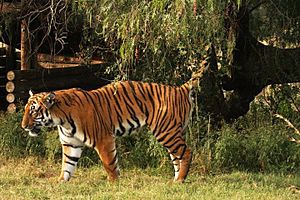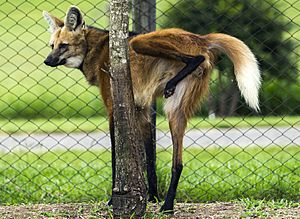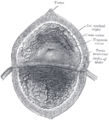Spraying (animal behavior) facts for kids


Scent marking is a special way animals use to show who owns a certain area. It's like putting up a "No Trespassing" sign, but with smells! Animals leave behind strong-smelling substances. Sometimes, this is called spraying when it involves urination.
These smells come from different places. Animals might use their urine or poop. They also have special scent glands on their bodies that produce these smells. Often, these scents contain special chemicals called pheromones. Pheromones are like secret messages that other animals can smell. They help the scent last longer too. Many mammals also mark by rubbing themselves against things to leave their scent behind. Animals often scent mark more when it's time to find a mate.
Contents
Why Animals Scent Mark
Animals use scent marking for many important reasons. The main reason is to show other animals that a certain area is their territory. This helps them avoid fights with other animals trying to move in. It's a way of saying, "This space is mine!"
Communicating with Smells
Scent marking is also a way for animals to communicate. They can tell other animals about themselves without even seeing them. For example, a scent might tell another animal if the marker is male or female. It can also tell if an animal is ready to mate. This "smell language" is very important in the animal world.
How Animals Scent Mark
Animals have many clever ways to leave their scent. The method often depends on the type of animal. Some animals use their bodies to rub scents onto objects. Others use their waste products like urine or feces.
Using Special Glands
Many animals have special scent glands. These glands are like tiny factories that make unique smells. The glands can be on different parts of their bodies. For example, some animals have glands on their faces, while others have them on their feet or near their tails. They rub these glands on trees, rocks, or even on other animals to spread their scent.
Marking with Urine and Feces
Urine and feces are common ways for animals to mark their territory. The smell in these can be very strong and last a long time. Some animals, like wolves, have a special way of urinating to mark. A male wolf will lift a hind leg and pee on a tree or bush. This is different from how they normally pee, which is usually done while squatting.
Different Animals, Different Ways
Many different kinds of animals use scent marking. Each species has its own unique style.
Big Cats and Their Rubs
Big cats like leopards and jaguars are part of the cat family. They mark their territory by rubbing their bodies against plants and trees. This leaves their scent behind for other cats to smell.
Lemurs and Their "Stink Fights"
Ring-tailed lemurs are very good at scent marking. Both male and female lemurs mark their territory. They use special glands near their bottom area. To mark tall surfaces, they might even do a handstand! They grab the highest point with their feet and then rub their scent on it. Male lemurs sometimes have "stink fights" where they wave their tails, covered in scent, at other males.
Wolves and Their Scent Posts
When a wolf marks its territory, it often chooses a "scent post." This is usually something raised, like a tree, rock, or bush. The wolf lifts one of its back legs and urinates on the scent post. This special way of peeing is only for marking.
Wombats and Their Cube Poop
Wombats have a very unusual way to mark their territory. They use their poop! Wombats have a special inside part of their body that makes their poop shaped like cubes. This cube shape is important because it stops the poop from rolling away. This way, their scent stays exactly where they want it to be.
Bees and Their Nest Scents
Even insects like the Eastern carpenter bee use scent marking. Both male and female bees have glands that help mark their nests. However, only the female bee can actually make the special marking substance. She puts this scent near the entrance of her nest to show it's her home.
Images for kids
-
Public toilet outside the Philadelphia City Hall
See also
 In Spanish: Micción para niños
In Spanish: Micción para niños




